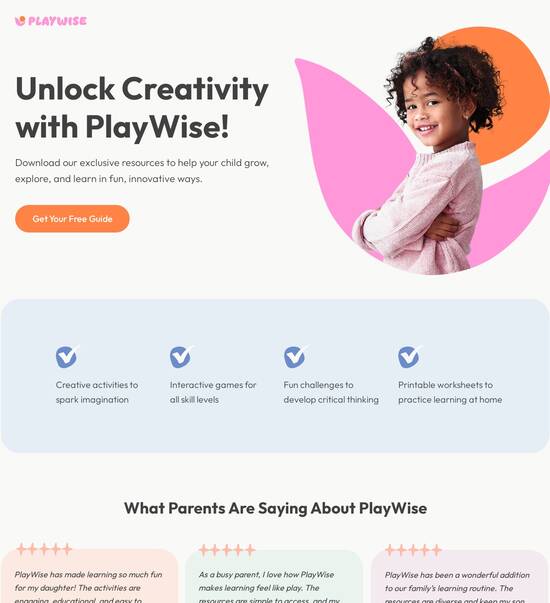
Vibrant API documentation page template
Explore Similar TemplatesAbout template
Unleash your creativity with the vibrant API documentation page template. Try Instapage today.
Recommended templates

Easy to build without coding
With the intuitive drag-and-drop builder, anyone on your team can create high-converting pages without any knowledge of code or design. Make enhancements to your landing page with custom widgets using Javascript, HTML/CSS, or third-party scripts.

Multiple layouts for any industry and goal
Select from 500+ landing page layouts built to boost conversions across industry-specific scenarios. Customize them by adjusting fonts, adding images, and generating on-brand content with the AI assistant. Quickly scale with Instablocks® and Global Blocks that you can save, reuse, and update globally.

Loads fast and looks polished on any device
Every template is responsive, which means they present professionally on any device and load blazingly fast with our Thor Render Engine. You can also power them up with Google AMP technology to deliver an unparalleled mobile experience and drive higher conversions.

Robust analytics & experimentation
Get real-time updates and reporting across all your devices, showing the number of visitors, conversions, cost-per-visitor, and cost-per-lead. Launch AI-powered experiments, run A/B tests, and use heatmaps to analyze user behavior, then optimize your landing page to maximize conversions.







Easy to build without coding
With the intuitive drag-and-drop builder, anyone on your team can create high-converting pages without any knowledge of code or design. Make enhancements to your landing page with custom widgets using Javascript, HTML/CSS, or third-party scripts.
Multiple layouts for any industry and goal
Select from 500+ landing page layouts built to boost conversions across industry-specific scenarios. Customize them by adjusting fonts, adding images, and generating on-brand content with the AI assistant. Quickly scale with Instablocks® and Global Blocks that you can save, reuse, and update globally.
Loads fast and looks polished on any device
Every template is responsive, which means they present professionally on any device and load blazingly fast with our Thor Render Engine.
Robust analytics & experimentation
Get real-time updates and reporting across all your devices, showing the number of visitors, conversions, cost-per-visitor, and cost-per-lead. Launch AI-powered experiments, run A/B tests, and use heatmaps to analyze user behavior, then optimize your landing page to maximize conversions.
All the features you need to build lead-generating landing pages
Explore more featuresLearn how to build top-performing landing pages for any goal
FAQs
Leading the way in building high-performing landing pages





A step-by-step guide to using Instapage for landing page optimization
Instapage offers a robust platform for marketers looking to accelerate and optimize their digital campaigns. This guide will take you through the essential steps to harness the full potential of Instapage's powerful features, ensuring that you can create high-converting landing pages effortlessly.
Understanding Instapage's unique capabilities
Instapage is built with a deep understanding of the marketing landscape, providing features specifically designed to enhance conversion rates. The platform allows you to create beautiful landing pages without needing coding skills and provides a suite of tools for ongoing optimization.
- Over 100 high-converting templates - Quickly launch your landing page using professionally designed templates that cater to various industries.
- Dynamic text replacement - Tailor your message based on the user's ad for maximum relevance.
- Built-in A/B testing tools - Experiment with different versions of your landing page to discover what works best.
Creating your first landing page
Getting started with Instapage is straightforward. By following these steps, you can create a landing page that captures leads effectively.
- Choose a template: Select a template that aligns with your campaign objectives and audience.
- Customize content: Add your branding, messaging, and ensure your call-to-action is clear.
- Utilize Instablocks: Use pre-designed content blocks to streamline your page construction.
Optimizing for conversions
Once your page is created, it's time to focus on optimization. Here are some vital steps:
- Analyze heatmaps: Use heatmaps to visualize where users are clicking and interacting with your content.
- Run A/B tests: Test various headlines or call-to-actions to determine the most effective options.
- Monitor analytics: Regularly check the performance metrics to make data-driven decisions.
By implementing these steps, you can significantly enhance the performance of your landing pages and maximize your returns on investment.
Engaging with the features of Instapage can transform your marketing approach and boost your lead generation efforts.
Ready to get started with optimized landing pages? Sign up for Instapage today and elevate your marketing campaigns.
People also ask about Vibrant API documentation page template
Unleashing the Power of Vibrant API Documentation Page Template
Understanding the vibrant API documentation framework
The purpose of API documentation is to provide both developers and users with a clear understanding of how to use an API effectively. It serves as a comprehensive guide detailing endpoints, request parameters, responses, and error codes. Vibrant API documentation goes a step further by not only conveying information but also engaging developers, enhancing their interaction with the API. This kind of documentation is visually appealing and well-organized, helping to establish a positive first impression and facilitating smoother onboarding.
The importance of vibrant documentation cannot be overstated, as it plays a critical role in developer engagement. A well-designed documentation page can reduce confusion, increase efficiency, and foster a sense of trust in the API provider. Key components include clarity, visual appeal, organization, and interactivity. An effective documentation template should incorporate these elements to ensure users can easily find what they need while feeling encouraged to explore further.
User-centric design: enhancing accessibility and usability
One significant aspect of a vibrant API documentation page template is its focus on user-centric design. This means creating experiences that require no hurdles, such as credit card requirements, to engage users. Developers often shy away from overly complicated sign-up processes, so allowing access to documentation without these obstacles can enhance user experience and encourage more developers to utilize the API.
Moreover, intuitive navigation is vital. A well-organized layout that allows easy access to various sections, like tutorials, code samples, and FAQs, empowers developers to find the information they need quickly. Features like a search bar and categorized endpoints can significantly improve the user experience. Finally, responsive design is essential in today’s multi-device world. Ensuring that documentation is accessible on desktops, tablets, and smartphones can expand the reach and usability of the API for developers on the go.
Crafting stunning media content
A vibrant API documentation page template can benefit significantly from the integration of rich media content. The media content generation process involves thoughtful planning and creativity, ensuring that visuals enhance understanding rather than hinder it. This includes creating diagrams, screenshots, and videos that clearly illustrate how the API functions. By aligning the media elements with the textual information, developers can see practical applications, thus better grasping the content of the documentation.
Integrating rich media elements is not just about aesthetics; it enhances engagement and understanding. For example, walkthrough videos can guide users through setting up their first application with the API, while interactive code samples can allow developers to test functionalities directly within the documentation. An effective image editor can further support these initiatives, providing a user-friendly way to create tailored visuals that complement the API's offerings.
Understanding client needs: customer-centric documentation development
To ensure that the documentation meets developers' needs, gathering customer feedback is essential. This feedback serves as the basis for tailoring content to better fit user requirements. Surveys, interviews, and usage analytics can all provide insights into which areas need improvement or expansion. Engaging users in the documentation process gives them a vested interest in its quality, creating a collaborative relationship between the API provider and its users.
Real-world applications of customer-centric documentation development can be found in numerous case studies. Companies that actively track customer requests and adapt their documentation accordingly often experience increased satisfaction and reduced support inquiries. The result is an empowered developer community that trusts the API provider, leading to higher usage rates and better overall performance.
Ensuring compliance with data regulations
In an era where data privacy is paramount, ensuring compliance with data regulations is essential in API usage. APIs often handle sensitive information, necessitating clear documentation of compliance procedures. An overview of data compliance in API documentation should outline essential policies like data protection, user consent, and data storage practices.
Best practices involve being transparent about compliance protocols within documentation. This includes user guides that highlight the measures in place for safeguarding data. Different regional regulations, such as GDPR in Europe or CCPA in California, can significantly influence documentation strategies. Adapting framework templates to include such information reassures users that the API provider is committed to responsible data management.
Simplifying data management: storing and processing information
Data management is a core aspect of any successful API, and it requires careful planning. Options for storing API request data vary widely, covering everything from local databases to cloud solutions. The critical overview includes weighing the pros and cons of each method to find the most effective solution for the API’s intended use and expected traffic levels.
REST APIs, for instance, are particularly well-suited for efficient data handling. They provide a standardized architectural style that allows developers to easily manage requests and responses. Strategies for effective data processing ensure that APIs can handle peak loads without compromising performance. Including these details in the documentation not only improves user understanding but also enhances the API's reliability.
The art of customization in API documentation
One of the hallmarks of a vibrant API documentation page template is its level of customization. Unlocking template editing capabilities allows developers to personalize their experience with the documentation, making it more relevant to their specific needs. This not only enhances learning but also contributes to a sense of ownership over the API's usage.
Leveraging customization to align with brand identity is another crucial aspect of vibrant documentation. By ensuring that the documentation matches the overall look and feel of the company’s website or product, users receive a cohesive brand message. Moreover, establishing a user feedback loop allows ongoing refinement of the documentation experience, ensuring that it continuously meets the needs of developers.
Optimizing performance through strategic design choices
In API documentation, performance metrics play a vital role in determining success. The importance of monitoring these metrics cannot be understated, as they provide insights into user engagement, content clarity, and overall usability. A thorough understanding of these metrics allows documentation teams to measure effectiveness and identify areas for improvement.
To measure and improve documentation performance, several tools and techniques can be employed. Utilizing analytics dashboards, heatmaps, and A/B testing can help discern how effectively users navigate the documentation. Applying this data can lead to strategic design choices—for instance, enhancing layout, adjusting content density, or modifying interactive elements to foster better engagement.
Navigating the challenges of API documentation
Creating API documentation is not devoid of challenges, with common pitfalls including unclear language, insufficient examples, or outdated information. Addressing these issues upfront can streamline the documentation creation process. Proactive strategies such as conducting regular audits and user testing can enhance documentation quality and reduce the likelihood of misunderstandings.
Document failures can serve as learning opportunities. Real-life scenarios where developers struggled due to poor documentation showcase the importance of clear, accurate, and current information. Such experiences highlight the necessity of continuous improvement and adaptation, ingraining a culture of quality within the documentation team.
Future trends in API documentation
As the digital landscape evolves, so too does the field of API documentation. Predictions for growth suggest that emerging technologies will significantly shape how documentation is produced and consumed. Innovations such as voice-enabled assistance and AI-driven content generation stand to revolutionize the landscape, giving developers instant access to relevant information.
The rising influence of AI in content generation is particularly noteworthy. With the potential to analyze vast datasets and tailor documentation to user queries, AI can enhance the personalization of API documentation. Preparing for tomorrow means embracing these tools while focusing on continuous improvement in the documentation process, ensuring it evolves alongside technological advancements.
Community and support: building a knowledge base
Building a knowledge base around API documentation is integral to fostering a thriving developer community. Community forums serve as platforms for collaboration, providing a space for developers to share insights, raise questions, and develop a deeper understanding of the API. Encouraging these discussions can lead to valuable contributions that enhance the overall quality of documentation.
Establishing support channels is also critical for ensuring that developers have continuous access to learning and assistance. Whether it's through chat support, ticketing systems, or regular webinars, enabling developers to find help quickly can greatly enhance their experience and trust in the API provider. This contributes to a supportive ecosystem that not only benefits users but also enriches the API documentation over time.
Case studies: success stories from innovative companies
Highlighting companies that effectively utilize vibrant API documentation can provide real insights into best practices. These success stories illustrate how well-crafted documentation has led to increased adoption rates and improved developer satisfaction. Examining these cases can guide others in their documentation efforts, showcasing tangible benefits and innovative approaches.
Furthermore, interviews with developers themselves can yield vital insights from the front lines of API usage. Their experiences can shed light on what they find most useful or confusing within documentation. Such qualitative data enables API providers to make targeted adjustments, ensuring the documentation continually meets the needs of its users.
Ready to skyrocket conversions?
Supercharge your ad campaigns with high-performing landing pages
Get started














